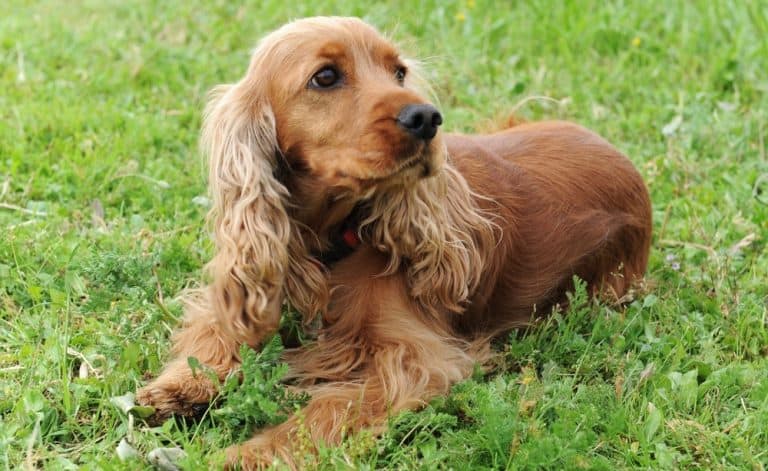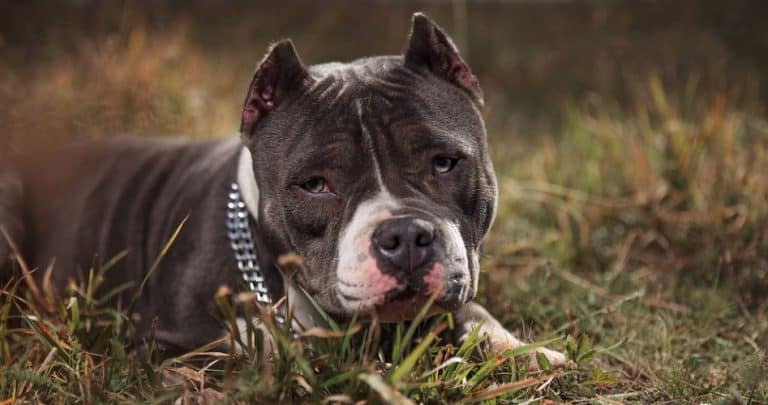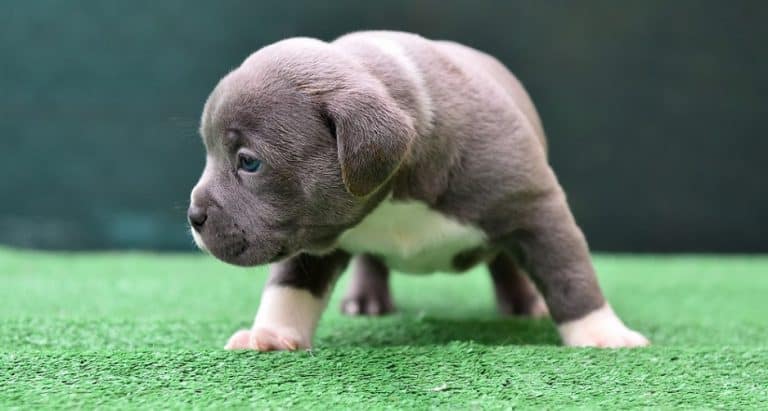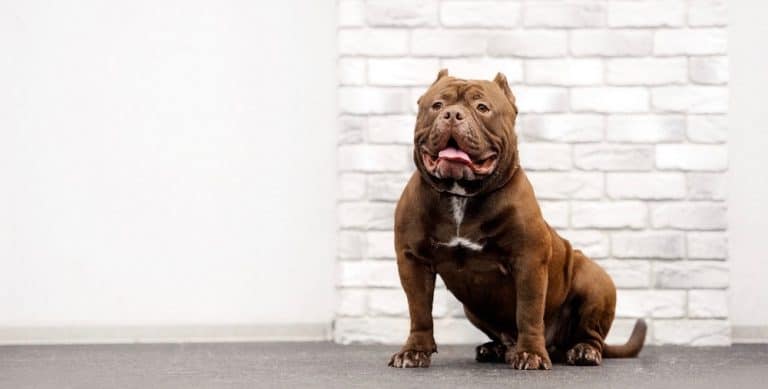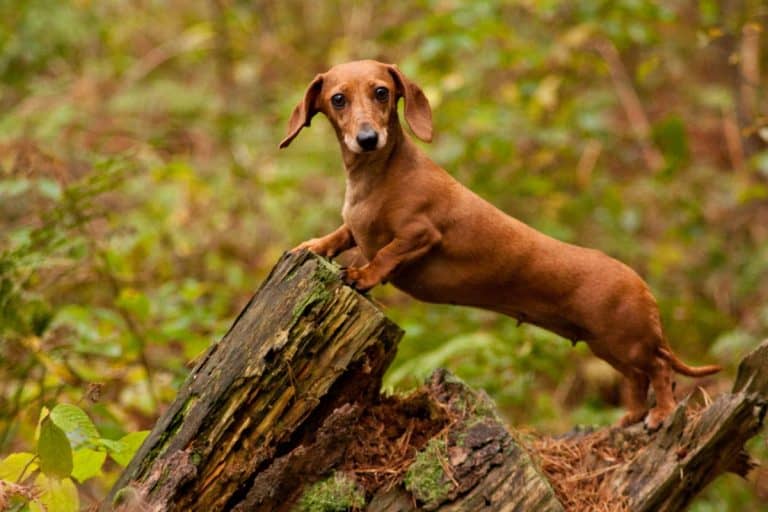The Complete Guide To Dapple Dachshunds
Based on looks, a lot of people are drawn to particular dog types and colors. They desire a special, lovely, and distinctive dog to be their buddy.
While there is nothing wrong with this, you should always make sure you’re buying a dog from a reputable breeder or retailer and that you understand the commitment you’re making.
These cautions apply to the dapple dachshund, one of the most distinctive-looking sausage dogs on the market.
Despite being excellent, robust dogs, dapple dachshunds must be carefully bred to prevent life-threatening health issues that can drastically reduce a dog’s quality of life.
In this guide, we will discuss everything that you need to know about the Dapple Dachshunds.
Thus, it will help you make your decision on whether you should purchase one or not.
Dapple Dachshund: What Are They?
Dachshunds with a specific coat pattern are known as dapple dachshunds.
You’ve seen a dapple if you’ve ever seen a dog with irregular spots of color on a solid or two-toned coat, frequently with one or both blue eyes.
This is known as a merle pattern in various dog breeds, notably herding breeds.
It is referred to as dapple coloration in dachshunds. The same genes are responsible for each and every color patch found on a dapple dachshund’s coat, whether there are several or just one.
The dapple coat pattern should be taken into consideration when breeding dachshunds.
Even though it typically only influences a dog’s appearance and not their temperament or health.
We’ll go through the information you should know about keeping and training dapple dachshunds further on in this article.
How Rare Are Dapple Dachshunds?
If you came across this dog in the street, you’d recognize their individuality if you’d seen a dapple or merle dog.
Each dapple dachshund is unique because even siblings belonging to the same litter can have drastically varied coloration and markings.
Some dapples have slightly discolored skin below, in addition to having different-colored fur patches.
Dapple dachshunds are quite uncommon because of their distinctive appearance and some of the risks associated with breeding them.
Dapple dachshund puppies are likely to find homes fast, and there may be a big waiting list for them.
The amount of dapple dachshunds in the USA or even the world is not easily quantifiable, although most breeders would view this as an uncommon coat pattern on a sausage dog.
Be extremely cautious when buying or purchasing a rare dapple dachshund, as they may have serious health issues if they were produced unethically.
How Can You Get Your Hands On A Dapple Dachshund?
The spotted coat on a Dapple Dachshund is a genetically inherited trait, like the majority of a dog’s physical characteristics.
A dachshund with a dappled parent may also have dapples on their own coat.
A litter of puppies that has at least one parent who is a dapple will have a 50% probability of getting the dapple pattern, since the dapple or merle gene is dominant.
A dapple dachshund may be a purebred, meaning that no other breed of dog can be found in their pedigree, because dappling is a potential dachshund feature.
Although, dapple dachshunds aren’t really “purebred” in the sense that they solely have dapple forebears, though.
In fact, breeding two dachshunds with the dapple pattern together is a horrible idea. The same holds true for various breeds of merle-patterned dogs.
A Glance At Dapple Dachshunds
The Dapple Dachshund can also be referred to as the Merle Dachshund or the Dapple Doxie.
Generally, these dogs are quite small, being between 8 and 9 inches tall, and weighing between 16 and 32 pounds. However, a miniature Dapple Dachshund could weigh as little as 11 pounds.
This breed of dog has quite a good lifespan of around 12 to 15 years. Their coats can be a mixture of long, wired or smooth.
As mentioned above, these dogs have a very distinctive coat, which sees patches of color on a solid colored coat.
Overall, these dogs are considered moderate when it comes to shedding, thus they do shed but not in large amounts.
As a result, depending on the length of their coat, you should aim to brush their coats once to three times a week.
A Dapple Dachshund is seen as a playful yet stubborn kind of dog. They are known to be difficult to train, yet they are great for families with children or new pet owners if you are patient and willing to put the time in to train them.
You can leave these dogs alone for a few hours while you are out at work, and they will be fine.
Yet, they do need between 30 minutes to an hour of exercise every day. In addition to that, Dapple Dachshunds are known to be barking dogs. Hence, they bark a lot!
On average, a new puppy could set you back $2,500 or more. While the average medical expenses of this breed of dog can be around $530.
The Coat Patterns Of A Dapple Dachshund
While certain dappling patterns are obvious and simple to spot, others are more complex.
However, a dachshund puppy must always be recorded as a dapple dachshund, if it even only has one dapple spot.
Dapple is more correctly known as a pattern, even though it is occasionally dubbed a “coloring.”
Dapples are available in a variety of hues, such as red, tan, black, cream and chocolate, black, and others.
Red dachshunds with dappling may initially have faint patterns that fade away as they mature.
Therefore, it is imperative to carefully inspect every red dachshund puppy in order to note any dappling.
A dapple parent is required for the pups to have this coat pattern because the dapple trait is dominant.
There will never be dapple dachshund offspring from two non-dapple parents. Dapple dachshunds exist in all shapes and sizes.
Although, the small, smooth, and long-haired varieties are the ones that are most usually bred for home use.
The History Of The Dapple Dachshund
All dachshunds were developed to hunt animals that live in burrows, therefore dapple dachshunds were no different.
The breed was developed in Germany as a working dog breed to hunt badgers, hares, and other creatures that burrow underground.
The sizes of those early Dachshunds varied widely. The canines used to hunt boar and badgers weighed between 30 and 35 pounds. Smaller 12-pound Dachshunds pursued hares and weasels, whereas larger 16 to 22-pound Dachshunds hunted foxes and deer.
Five-pound Dachshunds were used for a brief period in the early 20th century to bolt cottontail rabbits.
The breed, also known as the Teckel in Germany, was developed over a long period of time by German foresters in the 18th and 19th centuries.
They sought to create a courageous, long-legged dog that was capable of entering badger burrows and, if necessary, fighting the badger to the death within.
The Braque, a small French pointing breed, and the Pinscher, a miniature terrier-like breed, were crossed to produce the original kind of Dachshund, known as the Smooth.
The development of the Dachshund may also have been influenced by French Basset Hounds.
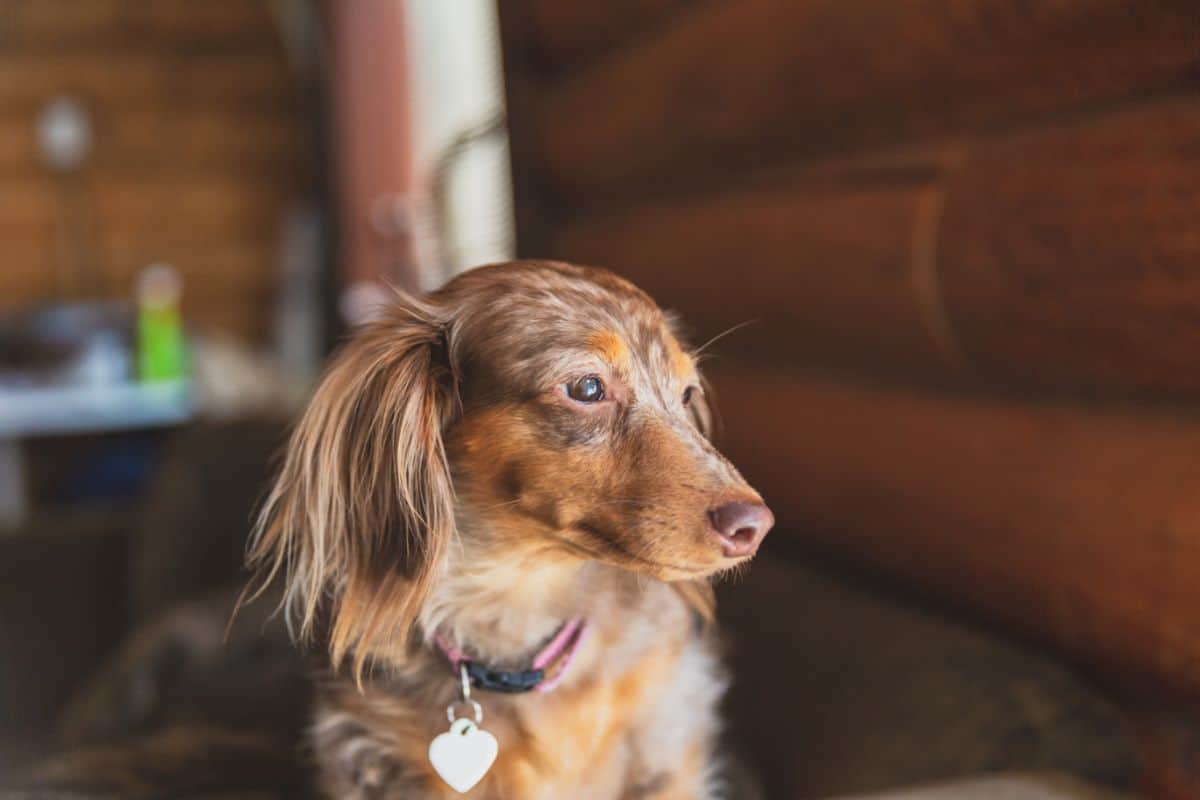
The wirehairs and long-coated Dachshunds were likely produced by crosses with terriers and other spaniels, respectively.
The Dachshund is currently the only breed recognized by the AKC that hunts both above and below ground, thanks to years of careful breeding.
Dachshunds vary in a variety of colors and patterns because, like most breeds that started out as working dogs, stature and conduct were more valued in the lineage than external appearances.
Bridle, bi-color, tri-color, and solid colors (other than white) are just a few of the patterns that can be found. Dapple is just another pattern that can be found on a Dachshund.
Temperament Of A Dapple Dachshund
You were mistaken in thinking that dachshunds with dapples would be less independent.
They are just as independent as sausage dogs with other coat patterns. These are small, self-reliant canines that lack self-awareness and are fearless.
Sometimes they may try and take on dogs that are considerably bigger than they are, which might bring them into danger.
Despite their lack of aggression, dachshunds are wary of both canine and human strangers.
They are good guard dogs because of their deep, powerful bark and inherent wariness.
Dachshunds are very devoted dogs despite their stubbornness, and they may develop a particularly close attachment with one family member.
This doesn’t exclude them from cuddling with other individuals in the house.
However, they could have a tendency to act like little shadows and stick close to one person.
Due to their intelligence and playfulness, dachshunds thrive with lots of playtime and puzzle toys.
It is necessary to keep in mind that even though dachshunds can tend to get along with other dogs, they sometimes struggle with other animals like birds, rabbits, or hamsters.
Do not forget that dachshunds have a high hunting drive because they were raised to hunt small animals. A dachshund might perceive any tiny animals you have inside your home as prey and hunt or attack them.
Although there is a chance, a dachshund and another tiny pet can coexist in peace. Yet, there is always a risk that one day they may attack that smaller creature.
Appearance And Size Of A Dapple Dachshund
The American Kennel Club (AKC) officially recognizes two dachshund sizes. This includes the standard size, which typically weighs between 16 and 32 pounds.
Then there is the miniature size, which often weighs under 11 pounds. However, generally, you will find a Dapple Dachshund to be around 12 to 15 pounds.
Dapple dachshunds stand out from other members of the breed in terms of appearance. In rarer cases, this breed of dog could be piebald.
Piebald is referring to a pattern of white and dark hues, or they may have one major coat color or a combination of colors (typically red or black and tan).
On top of those foundation hues, the dapple pattern will show as lighter patches that frequently have darker speckles.
Additionally, sometimes one or both their eyes will be a light blue color. These dogs can, just like all Dachshunds, live anywhere between 12 and 15 years.
All these reasons are why dapple dachshunds have become so popular, especially due to their incredibly unusual coat pattern.
Health Issues Associated With Dapple Dachshunds
Your dachshund shouldn’t be any more susceptible to health issues than other varieties of dachshunds, as long as they aren’t double dapples. A double dapple is when both parents are also Dapple Dachshunds.
Intervertebral Disc Disease
Unfortunately, there are some health problems that Dachshunds as a breed have as a whole commonly have.
Some are brought on by the dachshund’s peculiar shape, particularly its short rib cage, long spine, and small legs.
Intervertebral disc disease (IVDD), is a spine ailment that results in slipping or herniated discs, is particularly common in dachshunds.
It’s crucial to keep an eye on your dachshund’s spine because this disease can cause pain, restricted mobility, and even paralysis.
Progressive Retinal Apathy
Dachshunds are also susceptible to Progressive Retinal Apathy (PRA), a disorder in which the eye’s cells degenerate and finally cause blindness.
Although there is no known treatment for PRA, your dachshund will still lead a fulfilling life by relying on its other senses to get around.
However, these health concerns are another factor supporting the need to only purchase from trustworthy, knowledgeable breeders.
Professional breeders will be capable of providing you with full medical reports from the parents of the dog, and they will be knowledgeable about how to carefully select breeding couples to reduce the probability of inherited health concerns.
Obesity
The dachshund is also prone to obesity because of its small size and strong food desire.
Being overweight can put additional strain on a dachshund’s spine, so it’s crucial to keep an eye on their nutrition and offer them lots of exercise.
Through attempting to help your dachshund keep a healthy weight, you can avoid numerous joint and back issues.
Your veterinarian should be consulted frequently to ensure that they are sustaining a healthy weight, and you should alter the amount of food that you feed them as necessary.
Typically, they only need one cup of food every day, divided into 2 meals. The ideal meal to choose for small dog breeds is one that is low in both calories and fat and contains a good level of protein.
Selecting a healthy snack that won’t go directly to their hips is crucial.
Exercise Requirements Of A Dapple Dachshund
A dachshund’s legs are relatively short, so even if exercise is essential for maintaining a healthy weight in them, it’s also crucial to keep in mind that just a small amount of walking can go a long way.
The recommended amount of exercise per day is generally around 30 minutes, so if you enjoy long walks or runs, think about getting a doxie backpack to carry them after their legs fatigue.
Standard dachshunds require at least 60 minutes of physical activity each day as adults, whereas small dachshunds require at least 30.
For them to be content, healthy, and cognitively active, their activity should involve walks and games.
Puppies of dachshunds require 5 minutes of exercise per month of age. For example, a 3-month-old puppy needs 15 minutes of exercise per day.
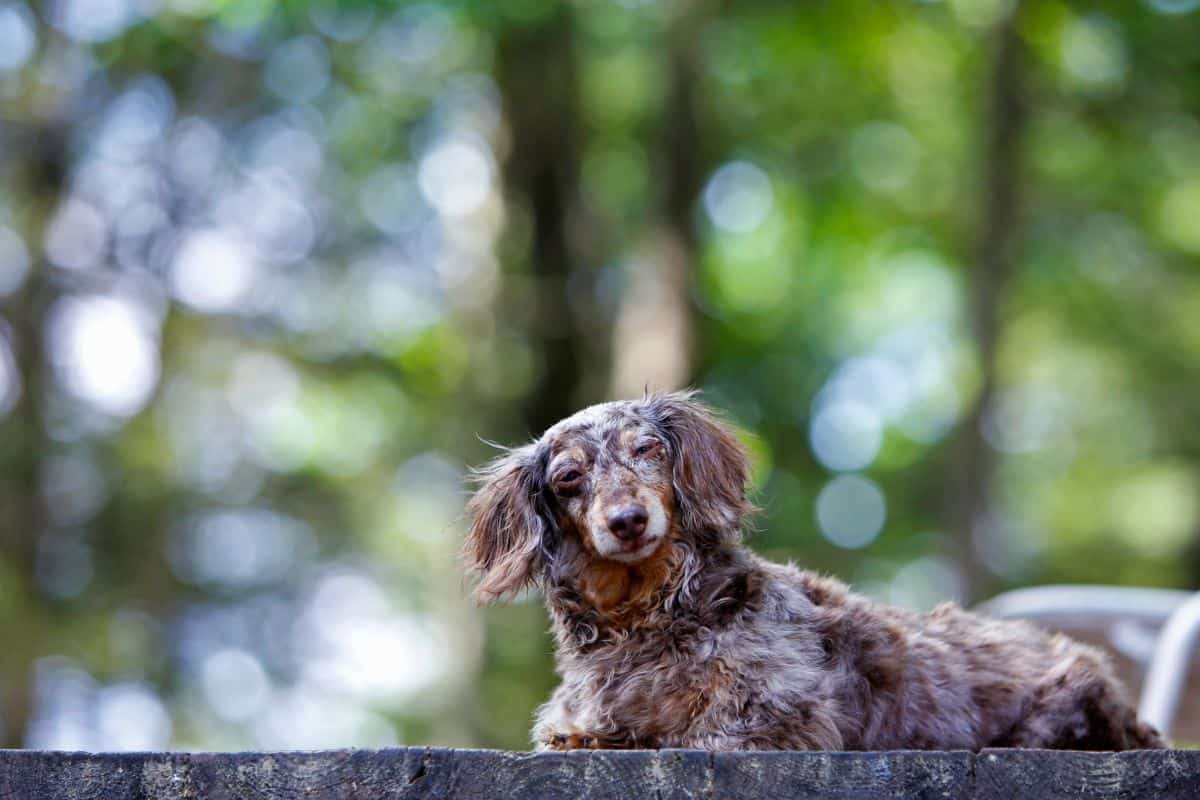
Start bringing them for walks when they are between 4 and 6 months old. However, this should only be done after they have received their shots.
Up until your dachshund puppy is one year old and completely formed, adhere to the 5 minute per month rule because that is an excellent approach to build it up.
At the start, you don’t want to overwork them. When puppies exercise too much before their bones stop growing, it may affect how they grow and develop.
As they age, you should gradually increase the length of their daily walks.
Alongside that, make sure your dachshund has a ramp or stairs to use because leaping up and down from objects such as furniture can lead to back pain and other potential injuries.
Grooming Requirements And Shedding Of A Dapple Dachshund
Depending on whether they have long hair, short hair, or wire hair, dapple dachshunds require different amounts of grooming time.
Short-haired or smooth-coated dachshunds simply need the occasional brushing and bath to maintain their coats.
A long-haired dachshund needs a lot more maintenance, such as more frequent brushing (2–3 times per week) to remove any matted or tangled fur, and a blow-dry after washing.
Two to three times a year, wire-haired dachshunds will need to have their undercoats professionally removed.
No matter how long their fur is, dachshunds will moderately shed. The long-haired dachshund, on the other hand, may appear to shed more than the others because of its considerably longer fur.
Other grooming duties for a dog of this size include cleaning the ears, brushing the teeth, and cutting nails. Just as you would with any other breed of dog.
Training A Dapple Dachshund
Unfortunately, the stubbornness of dachshunds—including dapple dachshunds—comes into play while teaching them.
Despite being very clever and food-motivated, this breed lacks the natural drive to please that beagles and border collies possess.
Training, including housebreaking, may become challenging as a result. The secret to being able to train and house train these dogs is consistency and patience.
With that being said, you should try to minimize your dachshund’s threat consumption during training.
It is important to keep in mind that they’ll do almost anything for a treat, and make the most of that fact.
Which could then lead you to overfeeding the dog and potential health issues.
Make training sessions enjoyable and brief. It’s preferable to take a breather and attempt it again later if you feel worn out and frustrated because your dachshund most likely feels the same way. Always give praise and provide constructive criticism.
Crate training can also aid in the process of housebreaking. When done correctly, your dachshund will regard their crate as a cozy place to rest. This will prevent them from going to the bathroom in your house while you are out.
Crates can be helpful for house training a dog. Yet, you should never leave a dog in one for more than a couple of hours at a time.
What Will Happen If Two Dapple Dachshunds Are Breed Together?
A dachshund with both parents being a dapple is referred to as a double dapple (also known as a double merle or in other breeds they are called a homozygous merle).
Their offspring would potentially have a 25% chance of becoming a double dachshund, which could face various health implications during its life.
In addition to the dapple pattern, this kind of dog will also have substantial areas of pure white fur.
Nevertheless, having two copies of the dapple gene affects the dachshund’s health too, most notably its eyes and ears, in addition to its appearance.
The risk of a double dapple having blindness, missing, or damaged eyes, as well as hearing impairment or being fully deaf, is extremely high.
This is why breeding two dapple dachshunds is wrong. Some dishonest breeders will try to do this in an effort to produce expensive and uncommon puppies to sell.
Background breeders who have good intentions yet ignorant may unintentionally do this.
Keep in mind that not all dapple dachshunds have a distinct color pattern; some might have only a single, small splotch. Also, in some cases, it only appears in young dapple dachshunds.
Always do your research to ensure you aren’t purchasing a double dapple if someone claims to have a rare dachshund or dapple to sell.
Otherwise, you can find yourself buying from a dishonest breeder a lot of money for a dog with significant medical issues.
A dog with a single copy of the dapple DNA shouldn’t experience any of the health issues that come with a double dapple.
Will A Single Dapple Dachshund Have The Same Health Issues As A Double Dapple?
Luckily, most dapple dachshunds are singles, and they are not particularly prone to any health issues beyond those that all dachshunds are. Your lone dapple dachshund ought to have a long and content life.
Puppy And Breeder Costs Of Dapple Dachshunds
Any purebred dog is likely to cost a lot of money. Since dapple dachshunds are sought-after and quite uncommon, they frequently cost much more than dachshunds with other coat patterns.
Prices will start at $2,500 and go as high as $3,500. Remember that while purchasing a dapple dachshund, it’s crucial to do so from a respected, respectable breeder.
Make sure that you aren’t purchasing a double dapple puppy which could have major health issues such as blindness or hearing.
It is important that you ask to see the parents of the puppies whenever feasible to make sure neither are dapples.
Below is a list of some of the most ethical and respectful Dapple Dachshund breeders in the country that you should consider.
- Dapple Doxie – Anywhere in the US, Dapple Doxie (Johnstown, CO) sends dapple dachshund puppies to. Yet, they only breed a particular type of Dachshunds. This includes dapple, English cream and piebald dachshunds. Both with short and long hair. Hence, they solely breed small dachshunds.
- Daisy Hill Dachshunds – A veterinarian and a veterinary nurse practitioner co-own Daisy-Hill Dachshunds in Fairfield, Maine. This company places a high priority on the wellbeing of their miniature doxies. Prior to adoption, all of their puppies undergo tests for seizure and PRA disorders.
- Full Circle Dachshunds – Only after litters are born and announced on Facebook do Full Circle Dachshunds (in Los Angeles County, California) take deposits for its miniature dachshunds. To find out about upcoming litters, you can get in touch with them directly.
- MyGaDachs – Two dapple females are available for breeding at the tiny, family-run breeder MyGaDachs (Augusta/Atlanta, GA). For further details, keep a watch on their future litter page.
- Normandox AKC Miniature Dachshunds – Long and short-haired dapples and piebald mini doxies are bred by Normandox AKC Miniature Dachshunds in Bakersfield, California. There is no waiting list, so to learn more about upcoming litters, get in touch with the owner or visit the website.
- Rockin L Dachshunds – A BBB-accredited company, Rockin L Dachshunds (Walsh, CO) has numerous miniature dachshund sires and dams available in various dapple hues. A $350 deposit is required, and every puppy is CKC registered.
Of course, you may always check shelters, foster homes, and dachshund rescue groups.
However, it can take some time before you discover one because dapples are not very common. However, if you have an open mind, you might be lucky!
Final Thoughts
Due to their tough personalities, Dapple Dachshunds can be a challenge for inexperienced dog owners.
These headstrong puppies are challenging to train and occasionally grumpy.
Despite their sensitive disposition, these lovely canines can form devoted and affectionate partners with careful training.
These puppies require only light mental activity and occasional brushing. If you are prepared to put in the time and effort, you will enjoy many years of affectionate companionship that will make your life more enjoyable and full of smiles and laughing.
We hope you have enjoyed this article, and have a better insight into Dapple Dachshunds.

